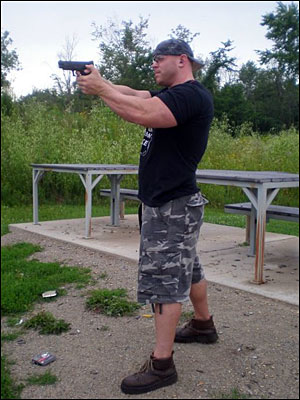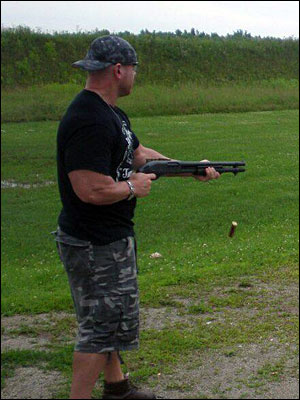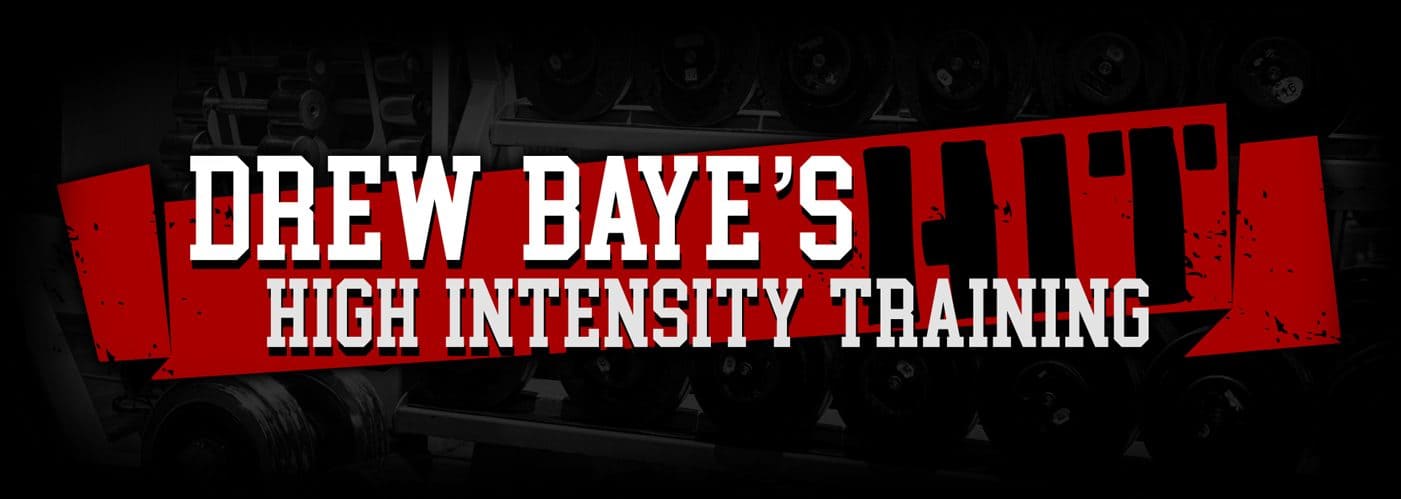While skill and tactics are the most important factors in surviving a gun fight, being stronger and better conditioned gives you several advantages which can mean the difference between being a survivor and a statistic. The stronger you are in general, the better and more quickly you will be able to move, the more stable your shooting platform will be regardless of your stance or position, and the more accurately you will be able to shoot whether standing, crouching, kneeling, prone, on your back or side, or whatever the terrain and available cover and concealment requires. The better your cardiovascular and metabolic conditioning, the less your accuracy and mobility will be compromised by fatigue.

A strong grip and forearms improves your accuracy and prevents “limp wrist” malfunctions – photo courtesy of David Baye
While it is important for any strength training program to provide balanced work for all the major muscle groups, shooters should pay special attention to their shoulders, arms, forearms and grip. Increasing your arm and shoulder strength increases shoulder stability reducing felt recoil and improving recoil management, especially when using pistols which are usually fired with the arms extended without the benefit of a shoulder stock for added stability. Increasing your grip and forearm strength improves your control and and helps prevent “limp wrist” malfunctions like stovepipe jams, failure to return to battery, and failure to chamber a round when using an automatic pistol.
Most people who work out train their arms and shoulders, but the forearms and grip often get neglected. This is unfortunate, because in addition to the specific benefits to shooting a strong grip and forearms allows you to better apply the strength of your other muscles to tasks which require gripping or holding things for lifting, carrying, pulling, or climbing, and using sports implements and heavy tools.
For general grip and forearm strengthening, the best exercises are gripping, wrist curls, wrist extensions, and reverse (overhand grip) arm curls with a thick bar, but to improve grip and forearm strength specifically for shooting I recommend also performing wrist adduction or ulnar deviation and wrist abduction or radial deviation.

Strong arms and shoulders improve your ability to manage recoil – photo courtesy of David Baye
Of the various types of grip strength you can train for, crushing strength is the most important for shooting. Crushing grip strength can be worked using using torsion spring grippers like the Captains of Crush and extension spring grippers like the Ivanko Super Gripper, or a plate loaded gripping machine if your gym has one. I do not recommend the type of torsion spring grippers commonly sold in sporting goods stores, as these tend to provide too little resistance to be used effectively by a man with even average grip strength. They’re fine for children or women just starting out, but most men will need a gripper that is much harder to close, ideally hard enough that you are only able to complete between six and ten strict repetitions.
If you don’t have a gripper you can work your crushing strength with static holds using a thick bar or thick handled cable attachment (static holds using a regular-diameter bar improves support strength rather than crushing strength) or simultaneously work your crushing and wrist extension strength performing thick bar reverse curls. If you don’t have one of these you can inexpensively convert regular bars into thick bars using products like Fat Gripz which fit over the bar increasing the gripping diameter.
I recommend also using thick bars for wrist curls and extensions, since reducing the finger flexion required to grip the bar improves your range of motion by preventing insufficiency of the pollicis longus, flexor digitorum superficialis, and flexor digitorum profundus during flexion (active) and extension (passive), since these muscles flex both your fingers and your wrists.
Because the axes your wrists flex and extend around are not perpendicular to your forearms, for optimal wrist alignment when using a barbell your wrists should be slightly wider than your elbows during wrist curls and slightly narrower than your elbows during wrist extensions. This positioning is not necessary when using dumbbells, since they allow your wrists to flex and extend independently in different planes.
Ulnar deviation (bending your wrist in the direction of your little finger) and radial deviation (bending your wrist in the direction of your thumb) is often performed using a sledge hammer, but you can also use an adjustable dumbbell with weight added to one side, or any handle with an end that can be attached to a cable or band.
If using a sledge hammer, as you get stronger you can increase the resistance by increasing the distance between your grip and the head of the hammer. If you do this I recommend adding lines to the length of the handle about one inch apart using pin striping or paint for precise positioning and progression.
To perform ulnar deviation hold the handle by your side with the weight behind your hand. Slowly bend your wrist back to raise the weight. If you’re using a sledge hammer start out by gripping the handle only a few inches from the weight, test the difficulty. If it isn’t at least moderately hard to lift, move your grip a little further away and test again. Continue until the weight feels heavy enough that you will only be able to complete a moderate number of repetitions. If you’re using a dumbbell or a handle attached to a cable or band, start with a moderate weight, test, and increase if necessary.
To perform radial deviation hold the handle by your side with the weight in front of your hand. Slowly bend your wrist forward to raise the weight. Adjust your grip if using a sledgehammer or the weight if using a dumbbell or handle attached to a cable or band until the weight feels challenging enough.

Since your grip and forearms get a lot of work during other exercises, especially heavy pulling movements like deadlifts, barbell rows, pulldowns, and weighted chin-ups, and since there is a lot of overlap in the muscles involved in each of these exercises, you don’t need to do all of them every time you train. Instead, alternate between performing the following two sequences at the end of your workouts:
A:
- Wrist extension
- Wrist curl
- Gripping
B:
- Ulnar deviation
- Radial deviation
- Thick bar reverse curl
The following is an example of how these grip and forearm specialization sequences can be combined with a basic full-body A/B routine. Lift and lower the weight under strict control, completing as many repetitions as possible in good form. Perform one set of each exercise using a weight that allows you to get between six and ten strict reps, and increase the weight by five pounds or five percent — whichever is smaller — whenever you are able to perform ten or more in good form. Allow no more than two minutes of rest between exercises and try to reduce this time as your conditioning improves to increase the cardiovascular and metabolic demands of the workout. Work out only two or three non-consecutive days per week to allow your body adequate time between workouts to recover and adapt. If you train with a high enough level of effort this is as much as you need. Use the other days to practice at the range or perform dry fire drills at home.
Workout A:
- Squat or Leg Press
- Chin-up or Underhand-grip Pulldown
- Chest Press
- Overhand or Parallel-grip Row
- Shoulder Press
- Stiff-leg Deadlift or Trunk Extension
- Neck Extension
- Neck Flexion
- Wrist extension
- Wrist curl
- Gripping
Workout B:
- Deadlift
- Parallel Bar Dip
- Parallel-Grip Pull-up or Wide-grip Pulldown
- Incline Chest Press
- Underhand-grip Row
- Heel Raise
- Weighted Crunch or Abdominal Machine
- Ulnar deviation
- Radial deviation
- Thick bar reverse curl

